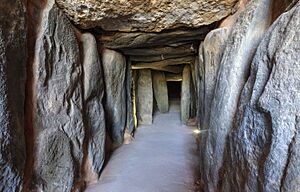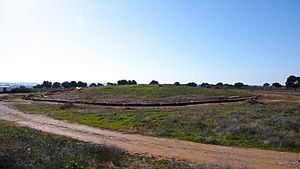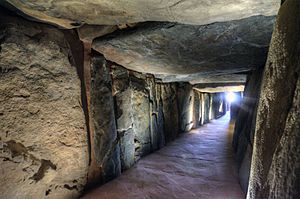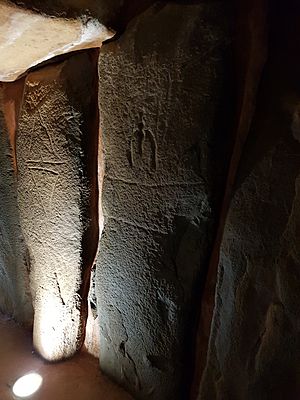Dolmen de Soto facts for kids
The Dolmen de Soto is an ancient underground structure built during the Neolithic period. It is located in Trigueros, a town in Andalucía, Spain. Experts believe it was built about 4,500 to 5,000 years ago. This dolmen is one of around 200 similar ancient burial sites found in the province of Huelva. These sites were used for rituals and burials long ago.
Discovering the Dolmen
The Dolmen de Soto was found by accident in 1922. A man named Armando de Soto Morillas wanted to build a new house on his land, called La Lobita. As they started digging, they discovered this amazing ancient site.
Later that same year, people began to excavate the burial site. By 1924, a famous German archaeologist named Hugo Obermaier was asked to study it. He was invited by the Duke of Alba, Jacobo Fitz-James Stuart.
Obermaier found eight bodies buried inside the dolmen. The bodies were placed in a curled-up position, like a baby before birth. Along with the bodies, he found various old objects. After his research, Obermaier wrote a book. This book described what he found and explained the features of this important burial place.
In 1931, the Dolmen de Soto was officially named a National Monument of Spain. However, it remained private property for many years. It wasn't until 1987 that it became part of the Spanish Ministry of Culture. This meant it was now protected by the government.
What the Dolmen Looks Like
From the outside, the Dolmen de Soto looks like a large, round hill. This mound is about 75 meters (246 feet) across.
Inside, there is a long, V-shaped passage. This passage is about 20.9 meters (68.6 feet) long. It starts at the western entrance, which is about 0.8 meters (2.6 feet) wide and 1.55 meters (5.1 feet) high. As you walk further in, the passage gets wider and taller. At its widest point in the east, it is 3.1 meters (10.2 feet) wide and 3.9 meters (12.8 feet) high.
At the very end of this passage, there is a special chamber. During the equinox (when day and night are almost equal length), the first rays of the sun shine directly into the passage and the chamber for a few minutes. People believe this was a way to show the idea of rebirth for those who were buried there.
The passage is made of many large standing stones. There are 31 stones on the northern side and 33 on the southern side. These stones are made from different types of rock, like quartzite, sandstone, and limestone. On top of these standing stones are 20 large flat stones called capstones. These capstones form the roof of the passage.
Many of the standing stones inside the dolmen have special carvings on them. Because of its size and the number of carvings, the Dolmen de Soto is considered one of the largest and most important dolmens in Spain.
Old Objects and Carvings
When the Dolmen de Soto was explored, eight human bodies were found. Each body was placed in a curled-up, fetal position. Next to each body, archaeologists found various objects. These objects included daggers, cups, and even ancient sea fossils.
Compared to other similar sites, not as many objects were found here. This makes experts think that the Dolmen de Soto might not have been used for a very long time.
The most interesting discoveries are the carvings, or engravings, on 43 of the standing stones. These carvings show different things. Some look like humans, while others show cups or knives. There are also many geometric shapes, like simple lines and circles. These engravings give us clues about the people who built and used this ancient place.
See also
 In Spanish: Dolmen de Soto para niños
In Spanish: Dolmen de Soto para niños





